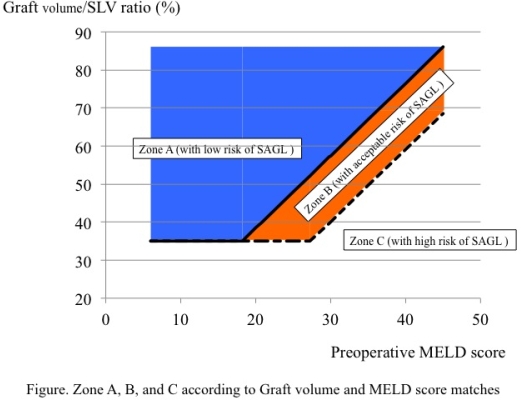Minimum Graft Size Avoiding Small-for-Size Associated Early Graft Failure in Living Donor Liver Transplantation.
S. Marubashi,1 H. Nagano,3 H. Eguchi,2 H. Wada,2 K. Umeshita,2 Y. Doki,2 M. Mori,2 N. Sato,1 T. Kimura,1 A. Kenjyo,1 M. Gotoh.1
1Regenerative Surgery, Fukushima Medical University, Fukushima, Japan
2Surgery, Osaka University Graduate School of Medicine, Suita, Japan.
Meeting: 2016 American Transplant Congress
Abstract number: A199
Keywords: Graft failure, Living-related liver donors, Outcome
Session Information
Session Name: Poster Session A: Living Donor Liver Transplantation
Session Type: Poster Session
Date: Saturday, June 11, 2016
Session Time: 5:30pm-7:30pm
 Presentation Time: 5:30pm-7:30pm
Presentation Time: 5:30pm-7:30pm
Location: Halls C&D
Small-for-size syndrome (SFSS) is a serious complication in living donor liver transplantation (LDLT). The aim of this study was to investigate the risk factors for graft failure, which associated with SFSS.
Patients and methods: 138 consecutive recipients of adult-to-adult LDLT between 1999 and Oct 2014 in our hospital were included in this study. We investigated the factors associated with small-for-size associated early graft loss (SAGL) using univariate/multivariate logistic regression analyses. Furthermore, a novel prediction model for SAGL was created using pre-operatively assessable risk factors.
Results: Twelve of the transplant recipients (8.8%) had SAGL. In multivariate logistic regression analyses using pre-operatively assessed variables, the pre-operative MELD score (P<0.001) and actual graft weight/recipient standard liver volume (SLV) ratio (P=0.008) were independent predictors of SAGL. The recommended graft volume by pre-operative CT volumetry was calculated as SLV x (1.616 x MELD+0.344)/100/0.85 (ml) [MELD ≥ 18.2], or SLV x 0.35 (ml) [MELD < 18.2]. The minimal graft volume was also calculated as SLV x (1.616 x MELD-14.139) /100/0.85 (ml) [MELD ≥ 27.2], or SLV x 0.35 (ml) [MELD < 27.2].
2D map with MELD and the graft volume/SLV ratio is shown in Figure. Zone A (with low risk of SAGL) is defined the area over “Recommended graft volume” by pre-operative CT volumetry. Zone B (with acceptable risk of SAGL); the area over “Minimal graft volume.” Zone C (with high risk of SAGL); the area below “Minimal graft volume.” Once you calculate the preoperative MELD score, the risk of SAGL is well determined by the graft volume/SLV ratio. For example, if MELD score is 30, the graft volume/SLV ratio should be over 57.4% for Zone A.
Zone A (with low risk of SAGL) is defined the area over “Recommended graft volume” by pre-operative CT volumetry. Zone B (with acceptable risk of SAGL); the area over “Minimal graft volume.” Zone C (with high risk of SAGL); the area below “Minimal graft volume.” Once you calculate the preoperative MELD score, the risk of SAGL is well determined by the graft volume/SLV ratio. For example, if MELD score is 30, the graft volume/SLV ratio should be over 57.4% for Zone A.
Conclusion:The required allograft volume in LDLT can be determined by the pre-operative MELD score of the recipient. Patients with higher MELD scores require larger grafts or even deceased donor whole liver transplant to avoid SAGL.
CITATION INFORMATION: Marubashi S, Nagano H, Eguchi H, Wada H, Umeshita K, Doki Y, Mori M, Sato N, Kimura T, Kenjyo A, Gotoh M. Minimum Graft Size Avoiding Small-for-Size Associated Early Graft Failure in Living Donor Liver Transplantation. Am J Transplant. 2016;16 (suppl 3).
To cite this abstract in AMA style:
Marubashi S, Nagano H, Eguchi H, Wada H, Umeshita K, Doki Y, Mori M, Sato N, Kimura T, Kenjyo A, Gotoh M. Minimum Graft Size Avoiding Small-for-Size Associated Early Graft Failure in Living Donor Liver Transplantation. [abstract]. Am J Transplant. 2016; 16 (suppl 3). https://atcmeetingabstracts.com/abstract/minimum-graft-size-avoiding-small-for-size-associated-early-graft-failure-in-living-donor-liver-transplantation/. Accessed January 5, 2026.« Back to 2016 American Transplant Congress
